Healthcare and Social Work Practices
VerifiedAdded on 2020/06/05
|16
|5368
|107
AI Summary
This assignment delves into the interconnected fields of healthcare and social work. It explores fundamental concepts such as professional accountability, ethical considerations, and effective care planning strategies. The document draws upon relevant literature and research to provide a comprehensive understanding of best practices within these vital sectors.
Contribute Materials
Your contribution can guide someone’s learning journey. Share your
documents today.

Physiological
Principles for Health and
Social Care
Principles for Health and
Social Care
Secure Best Marks with AI Grader
Need help grading? Try our AI Grader for instant feedback on your assignments.
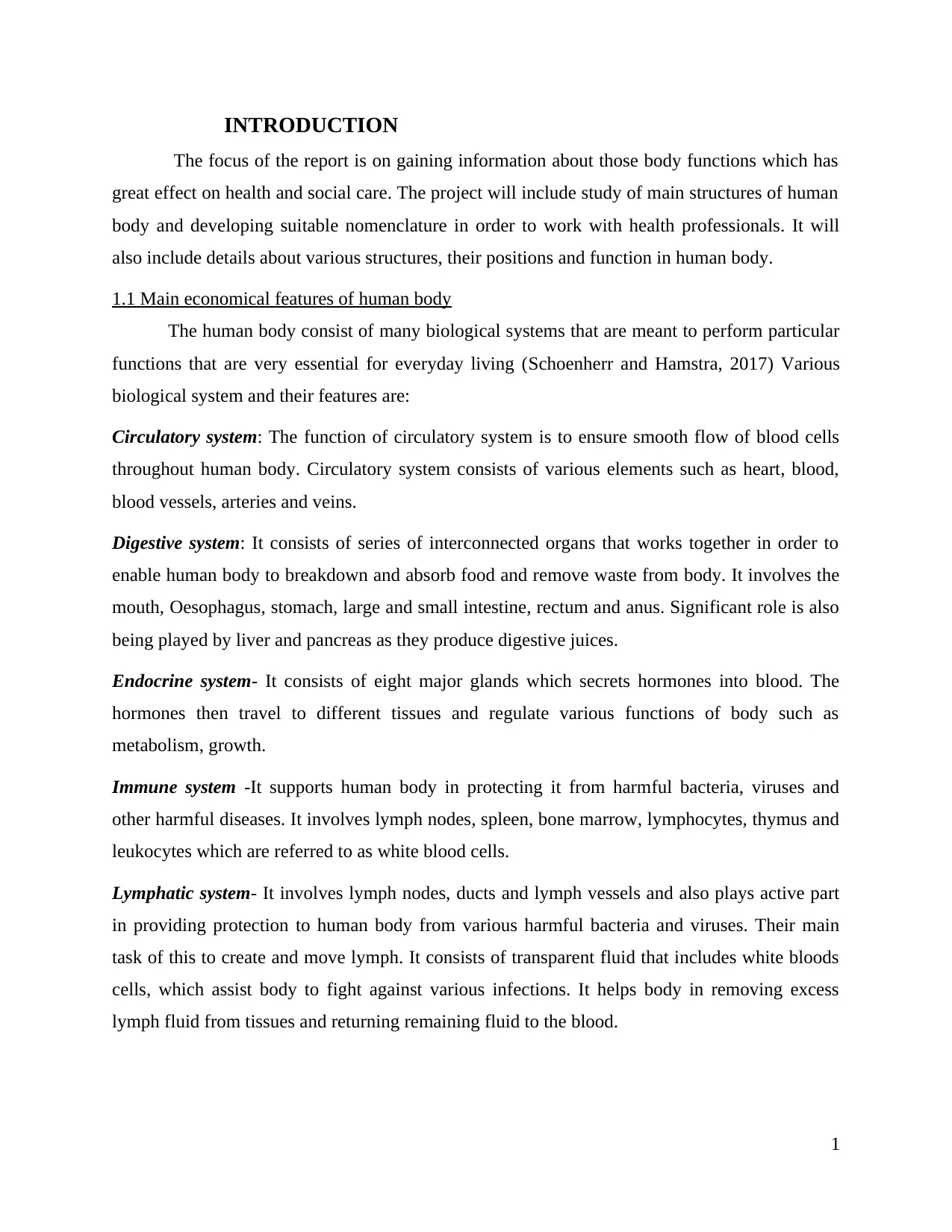
INTRODUCTION
The focus of the report is on gaining information about those body functions which has
great effect on health and social care. The project will include study of main structures of human
body and developing suitable nomenclature in order to work with health professionals. It will
also include details about various structures, their positions and function in human body.
1.1 Main economical features of human body
The human body consist of many biological systems that are meant to perform particular
functions that are very essential for everyday living (Schoenherr and Hamstra, 2017) Various
biological system and their features are:
Circulatory system: The function of circulatory system is to ensure smooth flow of blood cells
throughout human body. Circulatory system consists of various elements such as heart, blood,
blood vessels, arteries and veins.
Digestive system: It consists of series of interconnected organs that works together in order to
enable human body to breakdown and absorb food and remove waste from body. It involves the
mouth, Oesophagus, stomach, large and small intestine, rectum and anus. Significant role is also
being played by liver and pancreas as they produce digestive juices.
Endocrine system- It consists of eight major glands which secrets hormones into blood. The
hormones then travel to different tissues and regulate various functions of body such as
metabolism, growth.
Immune system -It supports human body in protecting it from harmful bacteria, viruses and
other harmful diseases. It involves lymph nodes, spleen, bone marrow, lymphocytes, thymus and
leukocytes which are referred to as white blood cells.
Lymphatic system- It involves lymph nodes, ducts and lymph vessels and also plays active part
in providing protection to human body from various harmful bacteria and viruses. Their main
task of this to create and move lymph. It consists of transparent fluid that includes white bloods
cells, which assist body to fight against various infections. It helps body in removing excess
lymph fluid from tissues and returning remaining fluid to the blood.
1
The focus of the report is on gaining information about those body functions which has
great effect on health and social care. The project will include study of main structures of human
body and developing suitable nomenclature in order to work with health professionals. It will
also include details about various structures, their positions and function in human body.
1.1 Main economical features of human body
The human body consist of many biological systems that are meant to perform particular
functions that are very essential for everyday living (Schoenherr and Hamstra, 2017) Various
biological system and their features are:
Circulatory system: The function of circulatory system is to ensure smooth flow of blood cells
throughout human body. Circulatory system consists of various elements such as heart, blood,
blood vessels, arteries and veins.
Digestive system: It consists of series of interconnected organs that works together in order to
enable human body to breakdown and absorb food and remove waste from body. It involves the
mouth, Oesophagus, stomach, large and small intestine, rectum and anus. Significant role is also
being played by liver and pancreas as they produce digestive juices.
Endocrine system- It consists of eight major glands which secrets hormones into blood. The
hormones then travel to different tissues and regulate various functions of body such as
metabolism, growth.
Immune system -It supports human body in protecting it from harmful bacteria, viruses and
other harmful diseases. It involves lymph nodes, spleen, bone marrow, lymphocytes, thymus and
leukocytes which are referred to as white blood cells.
Lymphatic system- It involves lymph nodes, ducts and lymph vessels and also plays active part
in providing protection to human body from various harmful bacteria and viruses. Their main
task of this to create and move lymph. It consists of transparent fluid that includes white bloods
cells, which assist body to fight against various infections. It helps body in removing excess
lymph fluid from tissues and returning remaining fluid to the blood.
1
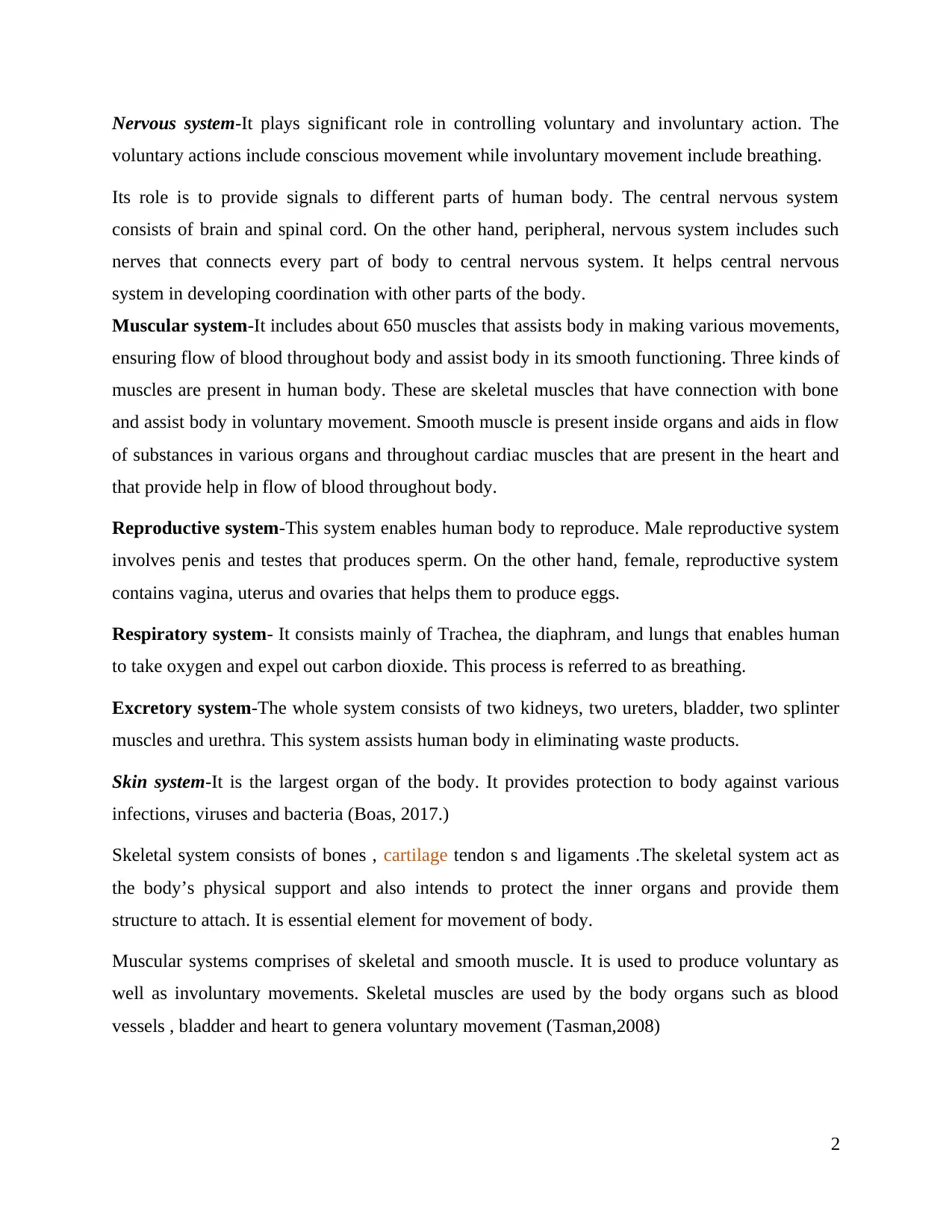
Nervous system-It plays significant role in controlling voluntary and involuntary action. The
voluntary actions include conscious movement while involuntary movement include breathing.
Its role is to provide signals to different parts of human body. The central nervous system
consists of brain and spinal cord. On the other hand, peripheral, nervous system includes such
nerves that connects every part of body to central nervous system. It helps central nervous
system in developing coordination with other parts of the body.
Muscular system-It includes about 650 muscles that assists body in making various movements,
ensuring flow of blood throughout body and assist body in its smooth functioning. Three kinds of
muscles are present in human body. These are skeletal muscles that have connection with bone
and assist body in voluntary movement. Smooth muscle is present inside organs and aids in flow
of substances in various organs and throughout cardiac muscles that are present in the heart and
that provide help in flow of blood throughout body.
Reproductive system-This system enables human body to reproduce. Male reproductive system
involves penis and testes that produces sperm. On the other hand, female, reproductive system
contains vagina, uterus and ovaries that helps them to produce eggs.
Respiratory system- It consists mainly of Trachea, the diaphram, and lungs that enables human
to take oxygen and expel out carbon dioxide. This process is referred to as breathing.
Excretory system-The whole system consists of two kidneys, two ureters, bladder, two splinter
muscles and urethra. This system assists human body in eliminating waste products.
Skin system-It is the largest organ of the body. It provides protection to body against various
infections, viruses and bacteria (Boas, 2017.)
Skeletal system consists of bones , cartilage tendon s and ligaments .The skeletal system act as
the body’s physical support and also intends to protect the inner organs and provide them
structure to attach. It is essential element for movement of body.
Muscular systems comprises of skeletal and smooth muscle. It is used to produce voluntary as
well as involuntary movements. Skeletal muscles are used by the body organs such as blood
vessels , bladder and heart to genera voluntary movement (Tasman,2008)
2
voluntary actions include conscious movement while involuntary movement include breathing.
Its role is to provide signals to different parts of human body. The central nervous system
consists of brain and spinal cord. On the other hand, peripheral, nervous system includes such
nerves that connects every part of body to central nervous system. It helps central nervous
system in developing coordination with other parts of the body.
Muscular system-It includes about 650 muscles that assists body in making various movements,
ensuring flow of blood throughout body and assist body in its smooth functioning. Three kinds of
muscles are present in human body. These are skeletal muscles that have connection with bone
and assist body in voluntary movement. Smooth muscle is present inside organs and aids in flow
of substances in various organs and throughout cardiac muscles that are present in the heart and
that provide help in flow of blood throughout body.
Reproductive system-This system enables human body to reproduce. Male reproductive system
involves penis and testes that produces sperm. On the other hand, female, reproductive system
contains vagina, uterus and ovaries that helps them to produce eggs.
Respiratory system- It consists mainly of Trachea, the diaphram, and lungs that enables human
to take oxygen and expel out carbon dioxide. This process is referred to as breathing.
Excretory system-The whole system consists of two kidneys, two ureters, bladder, two splinter
muscles and urethra. This system assists human body in eliminating waste products.
Skin system-It is the largest organ of the body. It provides protection to body against various
infections, viruses and bacteria (Boas, 2017.)
Skeletal system consists of bones , cartilage tendon s and ligaments .The skeletal system act as
the body’s physical support and also intends to protect the inner organs and provide them
structure to attach. It is essential element for movement of body.
Muscular systems comprises of skeletal and smooth muscle. It is used to produce voluntary as
well as involuntary movements. Skeletal muscles are used by the body organs such as blood
vessels , bladder and heart to genera voluntary movement (Tasman,2008)
2

The respiratory and circulatory system works together in order to deliver cells with
oxygen which is important for cellular respiration. This process includes breaking down of
glucose so that energy is released in a form that cells can then use, as carbon dioxide is produced
as a waste product. The carbon dioxide then needs to be excreted out from cells as it could
damage or lead to the death of a person. Glucose + oxygen carbon dioxide + water + energy. In
addition, the respiratory system is also accountable for getting oxygen into the human body and
carbon dioxide out. This occurs when person inhale (breathe in) and exhale (breath out). When
human being breathes in, they actually take in a mixture of gases from the air present in the
environment. The air moves down the trachea (or windpipe), then down into one of two narrower
tubes called bronchi (bronchus), then into smaller branching tubes called bronchioles which end
in tiny air sacs called alveoli (alveolus) (Draude, 2017)
3
Illustration 1: Features Of Human body
Source:(Human Physiology,2017)
oxygen which is important for cellular respiration. This process includes breaking down of
glucose so that energy is released in a form that cells can then use, as carbon dioxide is produced
as a waste product. The carbon dioxide then needs to be excreted out from cells as it could
damage or lead to the death of a person. Glucose + oxygen carbon dioxide + water + energy. In
addition, the respiratory system is also accountable for getting oxygen into the human body and
carbon dioxide out. This occurs when person inhale (breathe in) and exhale (breath out). When
human being breathes in, they actually take in a mixture of gases from the air present in the
environment. The air moves down the trachea (or windpipe), then down into one of two narrower
tubes called bronchi (bronchus), then into smaller branching tubes called bronchioles which end
in tiny air sacs called alveoli (alveolus) (Draude, 2017)
3
Illustration 1: Features Of Human body
Source:(Human Physiology,2017)
Secure Best Marks with AI Grader
Need help grading? Try our AI Grader for instant feedback on your assignments.
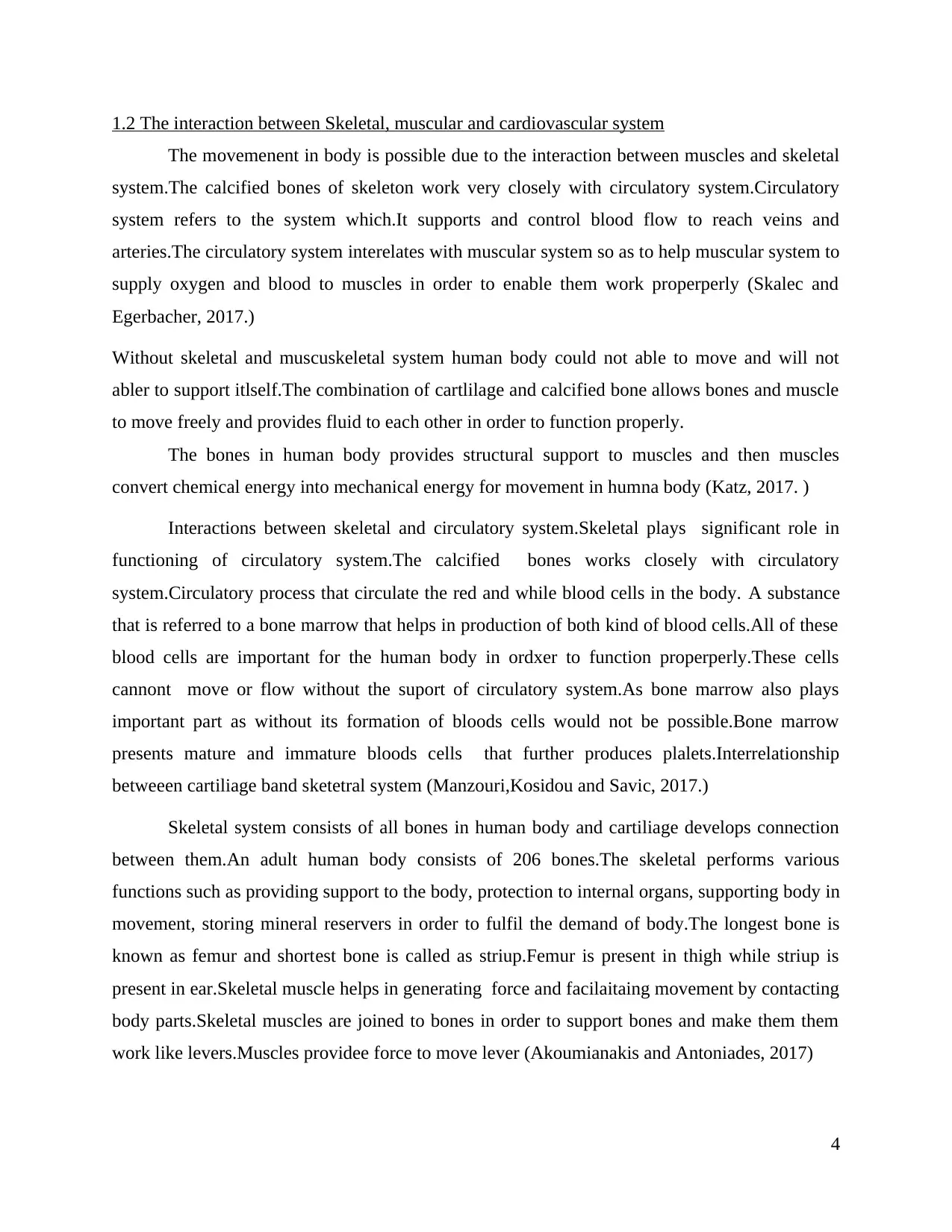
1.2 The interaction between Skeletal, muscular and cardiovascular system
The movemenent in body is possible due to the interaction between muscles and skeletal
system.The calcified bones of skeleton work very closely with circulatory system.Circulatory
system refers to the system which.It supports and control blood flow to reach veins and
arteries.The circulatory system interelates with muscular system so as to help muscular system to
supply oxygen and blood to muscles in order to enable them work properperly (Skalec and
Egerbacher, 2017.)
Without skeletal and muscuskeletal system human body could not able to move and will not
abler to support itlself.The combination of cartlilage and calcified bone allows bones and muscle
to move freely and provides fluid to each other in order to function properly.
The bones in human body provides structural support to muscles and then muscles
convert chemical energy into mechanical energy for movement in humna body (Katz, 2017. )
Interactions between skeletal and circulatory system.Skeletal plays significant role in
functioning of circulatory system.The calcified bones works closely with circulatory
system.Circulatory process that circulate the red and while blood cells in the body. A substance
that is referred to a bone marrow that helps in production of both kind of blood cells.All of these
blood cells are important for the human body in ordxer to function properperly.These cells
cannont move or flow without the suport of circulatory system.As bone marrow also plays
important part as without its formation of bloods cells would not be possible.Bone marrow
presents mature and immature bloods cells that further produces plalets.Interrelationship
betweeen cartiliage band sketetral system (Manzouri,Kosidou and Savic, 2017.)
Skeletal system consists of all bones in human body and cartiliage develops connection
between them.An adult human body consists of 206 bones.The skeletal performs various
functions such as providing support to the body, protection to internal organs, supporting body in
movement, storing mineral reservers in order to fulfil the demand of body.The longest bone is
known as femur and shortest bone is called as striup.Femur is present in thigh while striup is
present in ear.Skeletal muscle helps in generating force and facilaitaing movement by contacting
body parts.Skeletal muscles are joined to bones in order to support bones and make them them
work like levers.Muscles providee force to move lever (Akoumianakis and Antoniades, 2017)
4
The movemenent in body is possible due to the interaction between muscles and skeletal
system.The calcified bones of skeleton work very closely with circulatory system.Circulatory
system refers to the system which.It supports and control blood flow to reach veins and
arteries.The circulatory system interelates with muscular system so as to help muscular system to
supply oxygen and blood to muscles in order to enable them work properperly (Skalec and
Egerbacher, 2017.)
Without skeletal and muscuskeletal system human body could not able to move and will not
abler to support itlself.The combination of cartlilage and calcified bone allows bones and muscle
to move freely and provides fluid to each other in order to function properly.
The bones in human body provides structural support to muscles and then muscles
convert chemical energy into mechanical energy for movement in humna body (Katz, 2017. )
Interactions between skeletal and circulatory system.Skeletal plays significant role in
functioning of circulatory system.The calcified bones works closely with circulatory
system.Circulatory process that circulate the red and while blood cells in the body. A substance
that is referred to a bone marrow that helps in production of both kind of blood cells.All of these
blood cells are important for the human body in ordxer to function properperly.These cells
cannont move or flow without the suport of circulatory system.As bone marrow also plays
important part as without its formation of bloods cells would not be possible.Bone marrow
presents mature and immature bloods cells that further produces plalets.Interrelationship
betweeen cartiliage band sketetral system (Manzouri,Kosidou and Savic, 2017.)
Skeletal system consists of all bones in human body and cartiliage develops connection
between them.An adult human body consists of 206 bones.The skeletal performs various
functions such as providing support to the body, protection to internal organs, supporting body in
movement, storing mineral reservers in order to fulfil the demand of body.The longest bone is
known as femur and shortest bone is called as striup.Femur is present in thigh while striup is
present in ear.Skeletal muscle helps in generating force and facilaitaing movement by contacting
body parts.Skeletal muscles are joined to bones in order to support bones and make them them
work like levers.Muscles providee force to move lever (Akoumianakis and Antoniades, 2017)
4

TASK 2
2.1 Explaining normal body response to everyday activities
The regular physical activity have very crucial impact on body system which is based the
way human body responds. Each activity assists to fulfil regular requirement of body that are
essential for completing metabolic and nutritional process. The most essential activity is
breathing. Breathing is considered as psychological process of inhaling oxygen and exhaling
carbon dioxide. Once the oxygen is inhaled, its is carried to lung through respiratory system. The
respiratory system then send air to the lung, and then Thoracic volume enhances and it increases
the intra-Pulmonary preassure forces air to enter into lungs. Diaphragm and muscle relaxation
minimises the Thoracic volume and increases intra-pulmonary pressure above the atmospheric p
reassure, it results in exhalation of carbon-dioxide full blood. This process is directly interrelated
with the function of circulatory system. The oxygen distributed to small vessels which is referred
to as alveoli (Entwistle and Quick, 2006)
The 90 minute running after lunch has various benefits that are coordinated by internal
and external activities of the body. All organism collaborate with each other for gaining
5
Illustration 2: Interaction between Three major system
Source: (Relationship Between Major Body Systems,2017)
2.1 Explaining normal body response to everyday activities
The regular physical activity have very crucial impact on body system which is based the
way human body responds. Each activity assists to fulfil regular requirement of body that are
essential for completing metabolic and nutritional process. The most essential activity is
breathing. Breathing is considered as psychological process of inhaling oxygen and exhaling
carbon dioxide. Once the oxygen is inhaled, its is carried to lung through respiratory system. The
respiratory system then send air to the lung, and then Thoracic volume enhances and it increases
the intra-Pulmonary preassure forces air to enter into lungs. Diaphragm and muscle relaxation
minimises the Thoracic volume and increases intra-pulmonary pressure above the atmospheric p
reassure, it results in exhalation of carbon-dioxide full blood. This process is directly interrelated
with the function of circulatory system. The oxygen distributed to small vessels which is referred
to as alveoli (Entwistle and Quick, 2006)
The 90 minute running after lunch has various benefits that are coordinated by internal
and external activities of the body. All organism collaborate with each other for gaining
5
Illustration 2: Interaction between Three major system
Source: (Relationship Between Major Body Systems,2017)
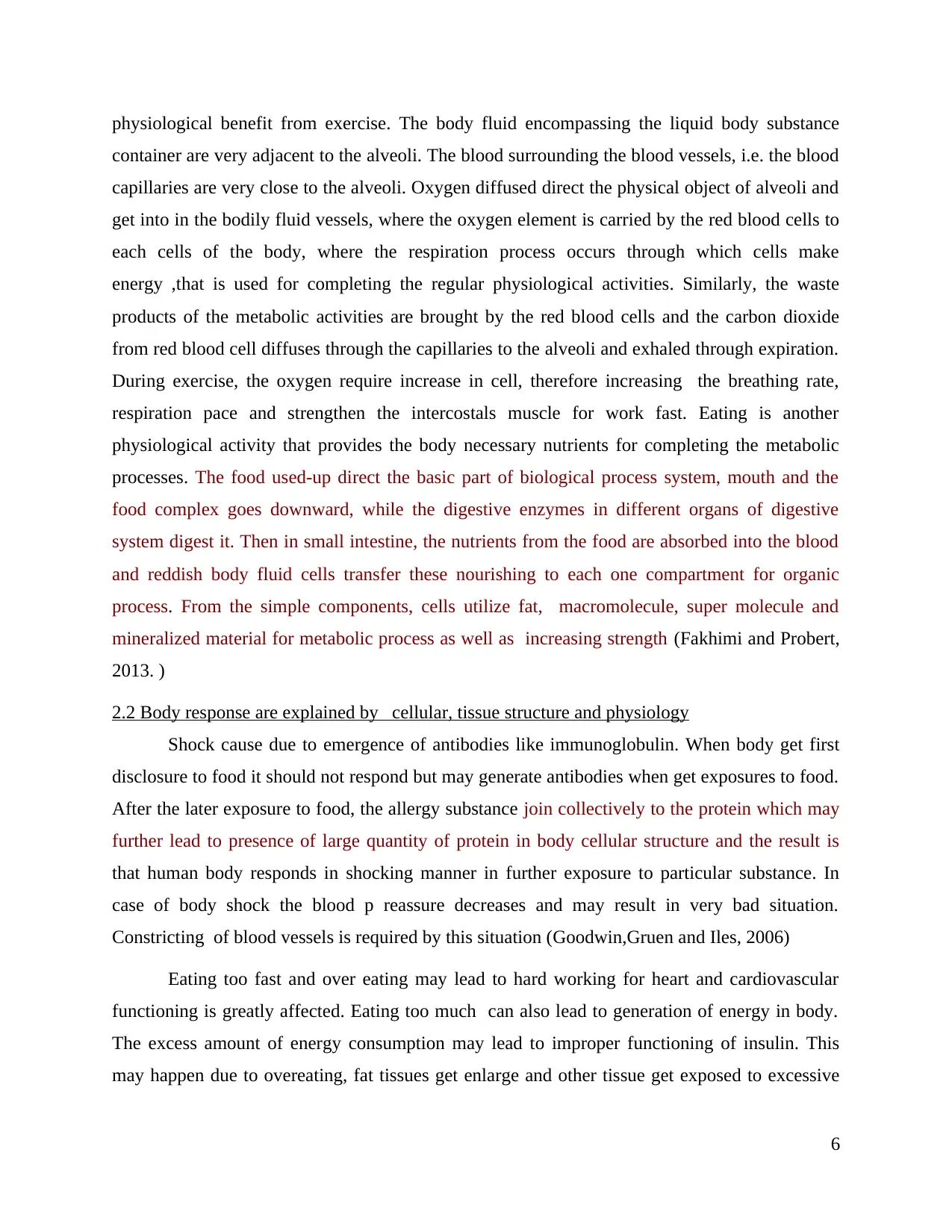
physiological benefit from exercise. The body fluid encompassing the liquid body substance
container are very adjacent to the alveoli. The blood surrounding the blood vessels, i.e. the blood
capillaries are very close to the alveoli. Oxygen diffused direct the physical object of alveoli and
get into in the bodily fluid vessels, where the oxygen element is carried by the red blood cells to
each cells of the body, where the respiration process occurs through which cells make
energy ,that is used for completing the regular physiological activities. Similarly, the waste
products of the metabolic activities are brought by the red blood cells and the carbon dioxide
from red blood cell diffuses through the capillaries to the alveoli and exhaled through expiration.
During exercise, the oxygen require increase in cell, therefore increasing the breathing rate,
respiration pace and strengthen the intercostals muscle for work fast. Eating is another
physiological activity that provides the body necessary nutrients for completing the metabolic
processes. The food used-up direct the basic part of biological process system, mouth and the
food complex goes downward, while the digestive enzymes in different organs of digestive
system digest it. Then in small intestine, the nutrients from the food are absorbed into the blood
and reddish body fluid cells transfer these nourishing to each one compartment for organic
process. From the simple components, cells utilize fat, macromolecule, super molecule and
mineralized material for metabolic process as well as increasing strength (Fakhimi and Probert,
2013. )
2.2 Body response are explained by cellular, tissue structure and physiology
Shock cause due to emergence of antibodies like immunoglobulin. When body get first
disclosure to food it should not respond but may generate antibodies when get exposures to food.
After the later exposure to food, the allergy substance join collectively to the protein which may
further lead to presence of large quantity of protein in body cellular structure and the result is
that human body responds in shocking manner in further exposure to particular substance. In
case of body shock the blood p reassure decreases and may result in very bad situation.
Constricting of blood vessels is required by this situation (Goodwin,Gruen and Iles, 2006)
Eating too fast and over eating may lead to hard working for heart and cardiovascular
functioning is greatly affected. Eating too much can also lead to generation of energy in body.
The excess amount of energy consumption may lead to improper functioning of insulin. This
may happen due to overeating, fat tissues get enlarge and other tissue get exposed to excessive
6
container are very adjacent to the alveoli. The blood surrounding the blood vessels, i.e. the blood
capillaries are very close to the alveoli. Oxygen diffused direct the physical object of alveoli and
get into in the bodily fluid vessels, where the oxygen element is carried by the red blood cells to
each cells of the body, where the respiration process occurs through which cells make
energy ,that is used for completing the regular physiological activities. Similarly, the waste
products of the metabolic activities are brought by the red blood cells and the carbon dioxide
from red blood cell diffuses through the capillaries to the alveoli and exhaled through expiration.
During exercise, the oxygen require increase in cell, therefore increasing the breathing rate,
respiration pace and strengthen the intercostals muscle for work fast. Eating is another
physiological activity that provides the body necessary nutrients for completing the metabolic
processes. The food used-up direct the basic part of biological process system, mouth and the
food complex goes downward, while the digestive enzymes in different organs of digestive
system digest it. Then in small intestine, the nutrients from the food are absorbed into the blood
and reddish body fluid cells transfer these nourishing to each one compartment for organic
process. From the simple components, cells utilize fat, macromolecule, super molecule and
mineralized material for metabolic process as well as increasing strength (Fakhimi and Probert,
2013. )
2.2 Body response are explained by cellular, tissue structure and physiology
Shock cause due to emergence of antibodies like immunoglobulin. When body get first
disclosure to food it should not respond but may generate antibodies when get exposures to food.
After the later exposure to food, the allergy substance join collectively to the protein which may
further lead to presence of large quantity of protein in body cellular structure and the result is
that human body responds in shocking manner in further exposure to particular substance. In
case of body shock the blood p reassure decreases and may result in very bad situation.
Constricting of blood vessels is required by this situation (Goodwin,Gruen and Iles, 2006)
Eating too fast and over eating may lead to hard working for heart and cardiovascular
functioning is greatly affected. Eating too much can also lead to generation of energy in body.
The excess amount of energy consumption may lead to improper functioning of insulin. This
may happen due to overeating, fat tissues get enlarge and other tissue get exposed to excessive
6
Paraphrase This Document
Need a fresh take? Get an instant paraphrase of this document with our AI Paraphraser
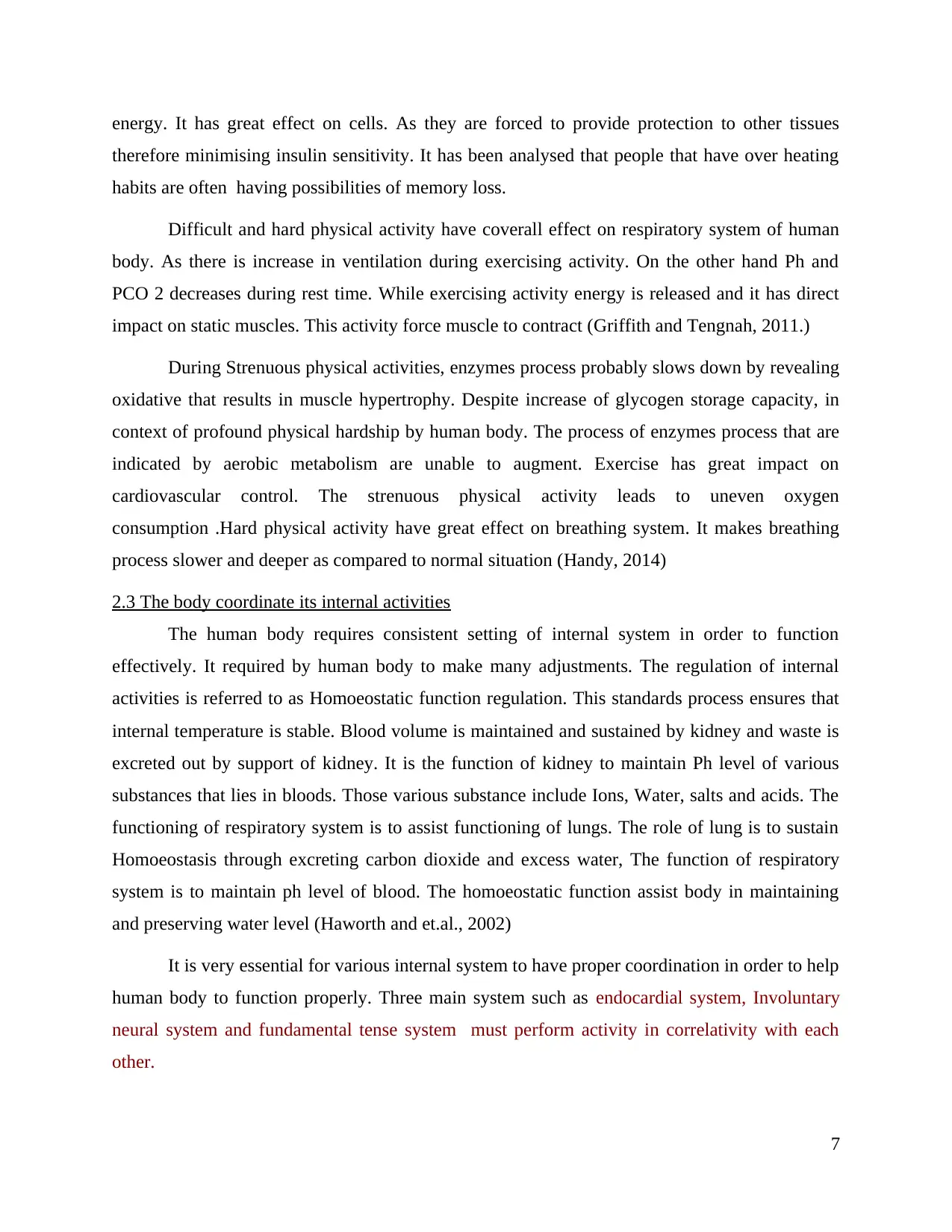
energy. It has great effect on cells. As they are forced to provide protection to other tissues
therefore minimising insulin sensitivity. It has been analysed that people that have over heating
habits are often having possibilities of memory loss.
Difficult and hard physical activity have coverall effect on respiratory system of human
body. As there is increase in ventilation during exercising activity. On the other hand Ph and
PCO 2 decreases during rest time. While exercising activity energy is released and it has direct
impact on static muscles. This activity force muscle to contract (Griffith and Tengnah, 2011.)
During Strenuous physical activities, enzymes process probably slows down by revealing
oxidative that results in muscle hypertrophy. Despite increase of glycogen storage capacity, in
context of profound physical hardship by human body. The process of enzymes process that are
indicated by aerobic metabolism are unable to augment. Exercise has great impact on
cardiovascular control. The strenuous physical activity leads to uneven oxygen
consumption .Hard physical activity have great effect on breathing system. It makes breathing
process slower and deeper as compared to normal situation (Handy, 2014)
2.3 The body coordinate its internal activities
The human body requires consistent setting of internal system in order to function
effectively. It required by human body to make many adjustments. The regulation of internal
activities is referred to as Homoeostatic function regulation. This standards process ensures that
internal temperature is stable. Blood volume is maintained and sustained by kidney and waste is
excreted out by support of kidney. It is the function of kidney to maintain Ph level of various
substances that lies in bloods. Those various substance include Ions, Water, salts and acids. The
functioning of respiratory system is to assist functioning of lungs. The role of lung is to sustain
Homoeostasis through excreting carbon dioxide and excess water, The function of respiratory
system is to maintain ph level of blood. The homoeostatic function assist body in maintaining
and preserving water level (Haworth and et.al., 2002)
It is very essential for various internal system to have proper coordination in order to help
human body to function properly. Three main system such as endocardial system, Involuntary
neural system and fundamental tense system must perform activity in correlativity with each
other.
7
therefore minimising insulin sensitivity. It has been analysed that people that have over heating
habits are often having possibilities of memory loss.
Difficult and hard physical activity have coverall effect on respiratory system of human
body. As there is increase in ventilation during exercising activity. On the other hand Ph and
PCO 2 decreases during rest time. While exercising activity energy is released and it has direct
impact on static muscles. This activity force muscle to contract (Griffith and Tengnah, 2011.)
During Strenuous physical activities, enzymes process probably slows down by revealing
oxidative that results in muscle hypertrophy. Despite increase of glycogen storage capacity, in
context of profound physical hardship by human body. The process of enzymes process that are
indicated by aerobic metabolism are unable to augment. Exercise has great impact on
cardiovascular control. The strenuous physical activity leads to uneven oxygen
consumption .Hard physical activity have great effect on breathing system. It makes breathing
process slower and deeper as compared to normal situation (Handy, 2014)
2.3 The body coordinate its internal activities
The human body requires consistent setting of internal system in order to function
effectively. It required by human body to make many adjustments. The regulation of internal
activities is referred to as Homoeostatic function regulation. This standards process ensures that
internal temperature is stable. Blood volume is maintained and sustained by kidney and waste is
excreted out by support of kidney. It is the function of kidney to maintain Ph level of various
substances that lies in bloods. Those various substance include Ions, Water, salts and acids. The
functioning of respiratory system is to assist functioning of lungs. The role of lung is to sustain
Homoeostasis through excreting carbon dioxide and excess water, The function of respiratory
system is to maintain ph level of blood. The homoeostatic function assist body in maintaining
and preserving water level (Haworth and et.al., 2002)
It is very essential for various internal system to have proper coordination in order to help
human body to function properly. Three main system such as endocardial system, Involuntary
neural system and fundamental tense system must perform activity in correlativity with each
other.
7
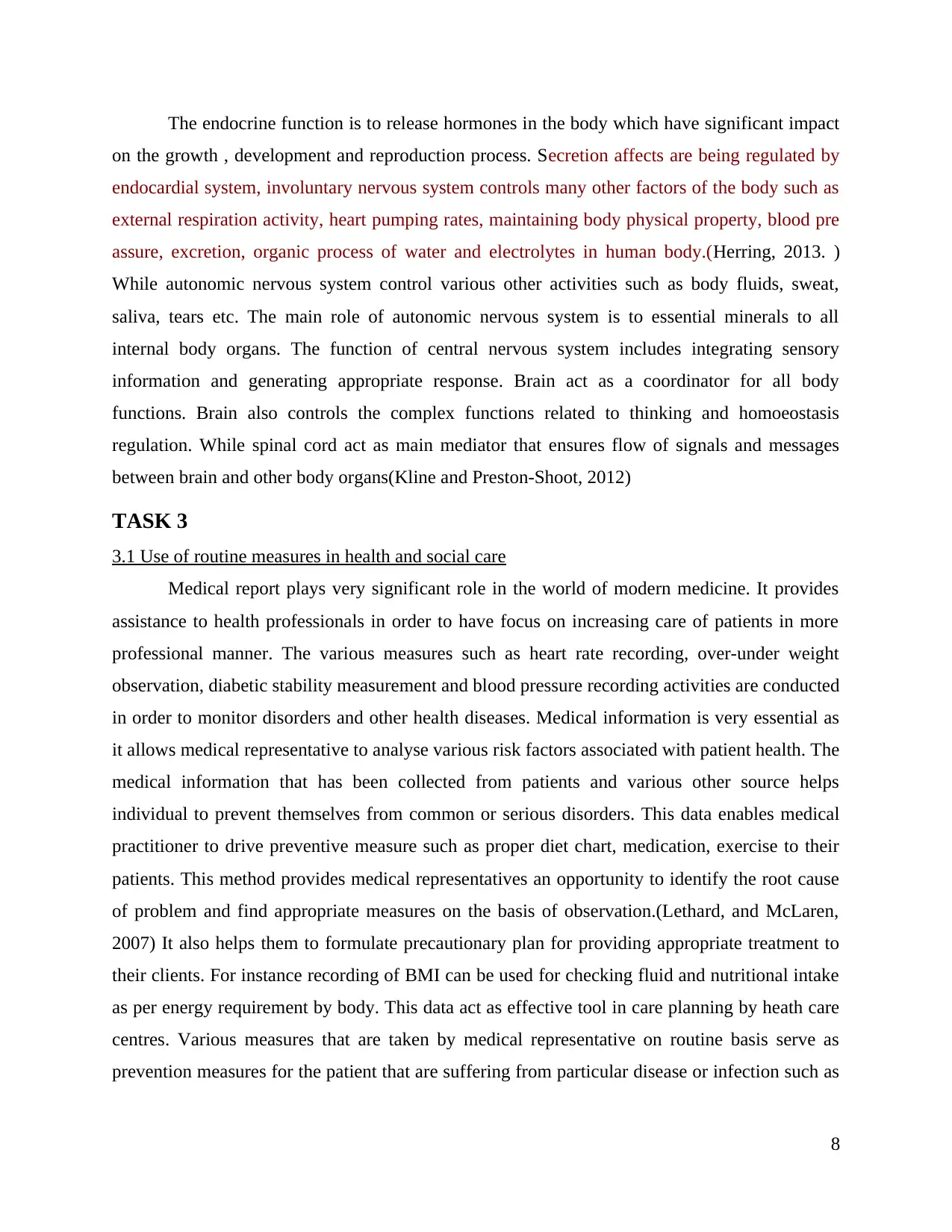
The endocrine function is to release hormones in the body which have significant impact
on the growth , development and reproduction process. Secretion affects are being regulated by
endocardial system, involuntary nervous system controls many other factors of the body such as
external respiration activity, heart pumping rates, maintaining body physical property, blood pre
assure, excretion, organic process of water and electrolytes in human body.(Herring, 2013. )
While autonomic nervous system control various other activities such as body fluids, sweat,
saliva, tears etc. The main role of autonomic nervous system is to essential minerals to all
internal body organs. The function of central nervous system includes integrating sensory
information and generating appropriate response. Brain act as a coordinator for all body
functions. Brain also controls the complex functions related to thinking and homoeostasis
regulation. While spinal cord act as main mediator that ensures flow of signals and messages
between brain and other body organs(Kline and Preston-Shoot, 2012)
TASK 3
3.1 Use of routine measures in health and social care
Medical report plays very significant role in the world of modern medicine. It provides
assistance to health professionals in order to have focus on increasing care of patients in more
professional manner. The various measures such as heart rate recording, over-under weight
observation, diabetic stability measurement and blood pressure recording activities are conducted
in order to monitor disorders and other health diseases. Medical information is very essential as
it allows medical representative to analyse various risk factors associated with patient health. The
medical information that has been collected from patients and various other source helps
individual to prevent themselves from common or serious disorders. This data enables medical
practitioner to drive preventive measure such as proper diet chart, medication, exercise to their
patients. This method provides medical representatives an opportunity to identify the root cause
of problem and find appropriate measures on the basis of observation.(Lethard, and McLaren,
2007) It also helps them to formulate precautionary plan for providing appropriate treatment to
their clients. For instance recording of BMI can be used for checking fluid and nutritional intake
as per energy requirement by body. This data act as effective tool in care planning by heath care
centres. Various measures that are taken by medical representative on routine basis serve as
prevention measures for the patient that are suffering from particular disease or infection such as
8
on the growth , development and reproduction process. Secretion affects are being regulated by
endocardial system, involuntary nervous system controls many other factors of the body such as
external respiration activity, heart pumping rates, maintaining body physical property, blood pre
assure, excretion, organic process of water and electrolytes in human body.(Herring, 2013. )
While autonomic nervous system control various other activities such as body fluids, sweat,
saliva, tears etc. The main role of autonomic nervous system is to essential minerals to all
internal body organs. The function of central nervous system includes integrating sensory
information and generating appropriate response. Brain act as a coordinator for all body
functions. Brain also controls the complex functions related to thinking and homoeostasis
regulation. While spinal cord act as main mediator that ensures flow of signals and messages
between brain and other body organs(Kline and Preston-Shoot, 2012)
TASK 3
3.1 Use of routine measures in health and social care
Medical report plays very significant role in the world of modern medicine. It provides
assistance to health professionals in order to have focus on increasing care of patients in more
professional manner. The various measures such as heart rate recording, over-under weight
observation, diabetic stability measurement and blood pressure recording activities are conducted
in order to monitor disorders and other health diseases. Medical information is very essential as
it allows medical representative to analyse various risk factors associated with patient health. The
medical information that has been collected from patients and various other source helps
individual to prevent themselves from common or serious disorders. This data enables medical
practitioner to drive preventive measure such as proper diet chart, medication, exercise to their
patients. This method provides medical representatives an opportunity to identify the root cause
of problem and find appropriate measures on the basis of observation.(Lethard, and McLaren,
2007) It also helps them to formulate precautionary plan for providing appropriate treatment to
their clients. For instance recording of BMI can be used for checking fluid and nutritional intake
as per energy requirement by body. This data act as effective tool in care planning by heath care
centres. Various measures that are taken by medical representative on routine basis serve as
prevention measures for the patient that are suffering from particular disease or infection such as
8
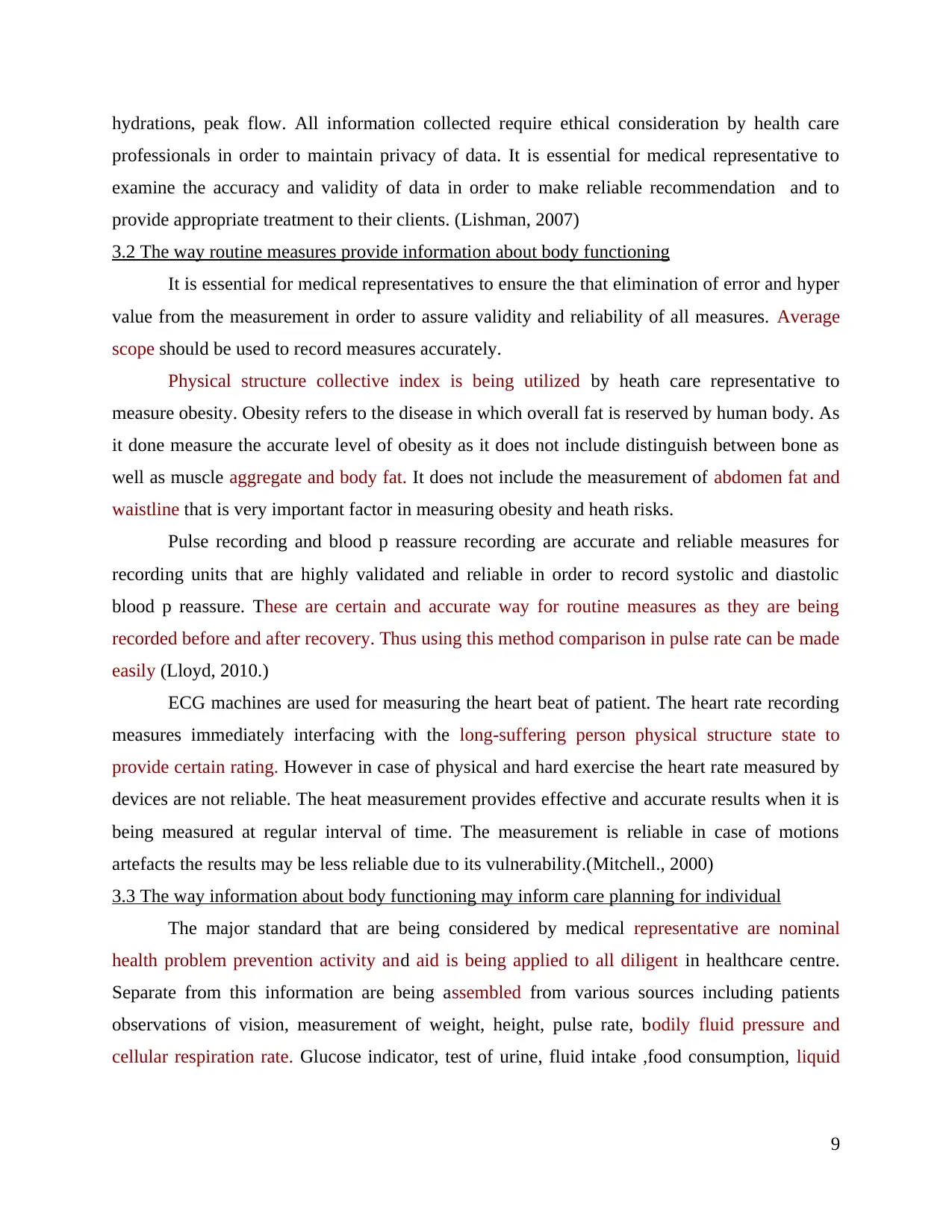
hydrations, peak flow. All information collected require ethical consideration by health care
professionals in order to maintain privacy of data. It is essential for medical representative to
examine the accuracy and validity of data in order to make reliable recommendation and to
provide appropriate treatment to their clients. (Lishman, 2007)
3.2 The way routine measures provide information about body functioning
It is essential for medical representatives to ensure the that elimination of error and hyper
value from the measurement in order to assure validity and reliability of all measures. Average
scope should be used to record measures accurately.
Physical structure collective index is being utilized by heath care representative to
measure obesity. Obesity refers to the disease in which overall fat is reserved by human body. As
it done measure the accurate level of obesity as it does not include distinguish between bone as
well as muscle aggregate and body fat. It does not include the measurement of abdomen fat and
waistline that is very important factor in measuring obesity and heath risks.
Pulse recording and blood p reassure recording are accurate and reliable measures for
recording units that are highly validated and reliable in order to record systolic and diastolic
blood p reassure. These are certain and accurate way for routine measures as they are being
recorded before and after recovery. Thus using this method comparison in pulse rate can be made
easily (Lloyd, 2010.)
ECG machines are used for measuring the heart beat of patient. The heart rate recording
measures immediately interfacing with the long-suffering person physical structure state to
provide certain rating. However in case of physical and hard exercise the heart rate measured by
devices are not reliable. The heat measurement provides effective and accurate results when it is
being measured at regular interval of time. The measurement is reliable in case of motions
artefacts the results may be less reliable due to its vulnerability.(Mitchell., 2000)
3.3 The way information about body functioning may inform care planning for individual
The major standard that are being considered by medical representative are nominal
health problem prevention activity and aid is being applied to all diligent in healthcare centre.
Separate from this information are being assembled from various sources including patients
observations of vision, measurement of weight, height, pulse rate, bodily fluid pressure and
cellular respiration rate. Glucose indicator, test of urine, fluid intake ,food consumption, liquid
9
professionals in order to maintain privacy of data. It is essential for medical representative to
examine the accuracy and validity of data in order to make reliable recommendation and to
provide appropriate treatment to their clients. (Lishman, 2007)
3.2 The way routine measures provide information about body functioning
It is essential for medical representatives to ensure the that elimination of error and hyper
value from the measurement in order to assure validity and reliability of all measures. Average
scope should be used to record measures accurately.
Physical structure collective index is being utilized by heath care representative to
measure obesity. Obesity refers to the disease in which overall fat is reserved by human body. As
it done measure the accurate level of obesity as it does not include distinguish between bone as
well as muscle aggregate and body fat. It does not include the measurement of abdomen fat and
waistline that is very important factor in measuring obesity and heath risks.
Pulse recording and blood p reassure recording are accurate and reliable measures for
recording units that are highly validated and reliable in order to record systolic and diastolic
blood p reassure. These are certain and accurate way for routine measures as they are being
recorded before and after recovery. Thus using this method comparison in pulse rate can be made
easily (Lloyd, 2010.)
ECG machines are used for measuring the heart beat of patient. The heart rate recording
measures immediately interfacing with the long-suffering person physical structure state to
provide certain rating. However in case of physical and hard exercise the heart rate measured by
devices are not reliable. The heat measurement provides effective and accurate results when it is
being measured at regular interval of time. The measurement is reliable in case of motions
artefacts the results may be less reliable due to its vulnerability.(Mitchell., 2000)
3.3 The way information about body functioning may inform care planning for individual
The major standard that are being considered by medical representative are nominal
health problem prevention activity and aid is being applied to all diligent in healthcare centre.
Separate from this information are being assembled from various sources including patients
observations of vision, measurement of weight, height, pulse rate, bodily fluid pressure and
cellular respiration rate. Glucose indicator, test of urine, fluid intake ,food consumption, liquid
9
Secure Best Marks with AI Grader
Need help grading? Try our AI Grader for instant feedback on your assignments.
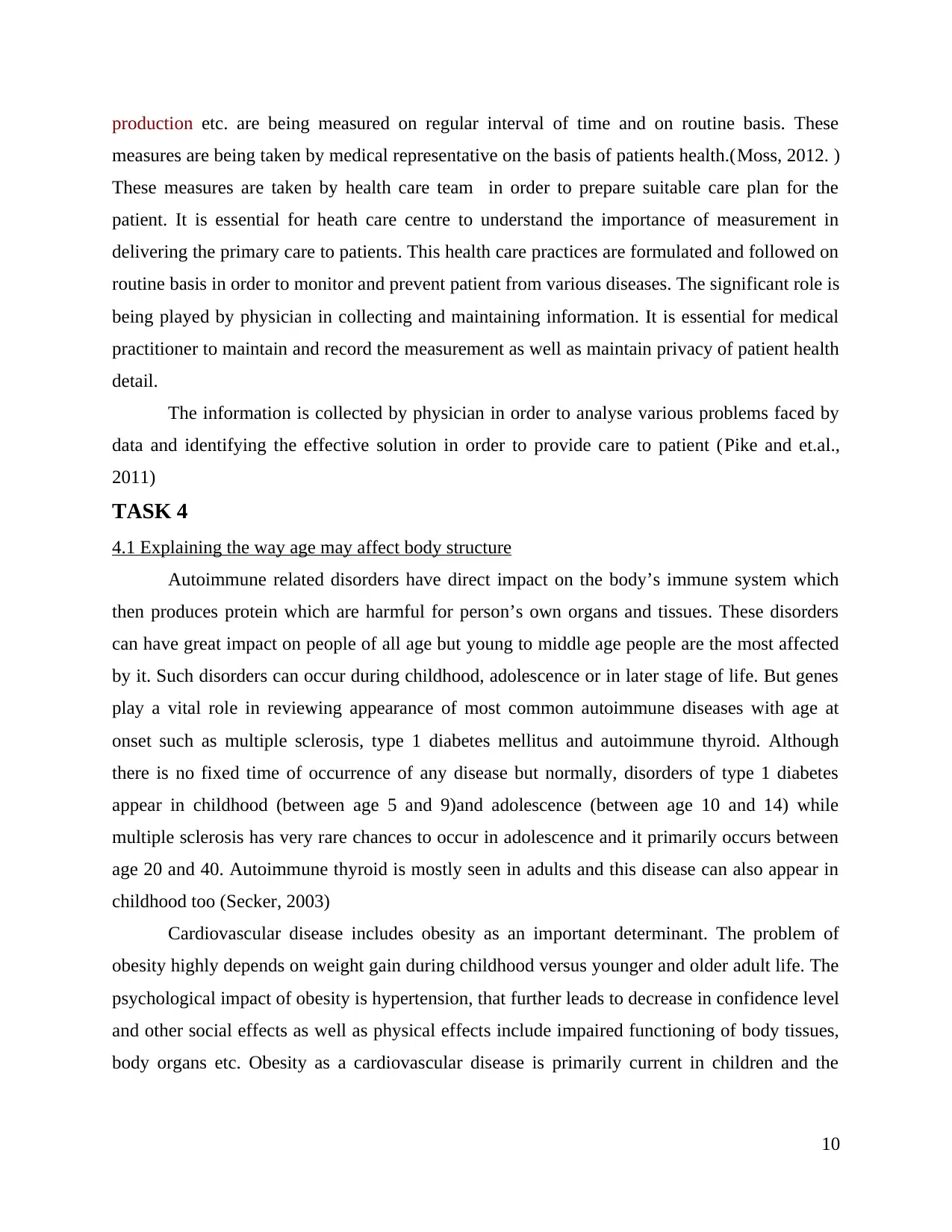
production etc. are being measured on regular interval of time and on routine basis. These
measures are being taken by medical representative on the basis of patients health.(Moss, 2012. )
These measures are taken by health care team in order to prepare suitable care plan for the
patient. It is essential for heath care centre to understand the importance of measurement in
delivering the primary care to patients. This health care practices are formulated and followed on
routine basis in order to monitor and prevent patient from various diseases. The significant role is
being played by physician in collecting and maintaining information. It is essential for medical
practitioner to maintain and record the measurement as well as maintain privacy of patient health
detail.
The information is collected by physician in order to analyse various problems faced by
data and identifying the effective solution in order to provide care to patient (Pike and et.al.,
2011)
TASK 4
4.1 Explaining the way age may affect body structure
Autoimmune related disorders have direct impact on the body’s immune system which
then produces protein which are harmful for person’s own organs and tissues. These disorders
can have great impact on people of all age but young to middle age people are the most affected
by it. Such disorders can occur during childhood, adolescence or in later stage of life. But genes
play a vital role in reviewing appearance of most common autoimmune diseases with age at
onset such as multiple sclerosis, type 1 diabetes mellitus and autoimmune thyroid. Although
there is no fixed time of occurrence of any disease but normally, disorders of type 1 diabetes
appear in childhood (between age 5 and 9)and adolescence (between age 10 and 14) while
multiple sclerosis has very rare chances to occur in adolescence and it primarily occurs between
age 20 and 40. Autoimmune thyroid is mostly seen in adults and this disease can also appear in
childhood too (Secker, 2003)
Cardiovascular disease includes obesity as an important determinant. The problem of
obesity highly depends on weight gain during childhood versus younger and older adult life. The
psychological impact of obesity is hypertension, that further leads to decrease in confidence level
and other social effects as well as physical effects include impaired functioning of body tissues,
body organs etc. Obesity as a cardiovascular disease is primarily current in children and the
10
measures are being taken by medical representative on the basis of patients health.(Moss, 2012. )
These measures are taken by health care team in order to prepare suitable care plan for the
patient. It is essential for heath care centre to understand the importance of measurement in
delivering the primary care to patients. This health care practices are formulated and followed on
routine basis in order to monitor and prevent patient from various diseases. The significant role is
being played by physician in collecting and maintaining information. It is essential for medical
practitioner to maintain and record the measurement as well as maintain privacy of patient health
detail.
The information is collected by physician in order to analyse various problems faced by
data and identifying the effective solution in order to provide care to patient (Pike and et.al.,
2011)
TASK 4
4.1 Explaining the way age may affect body structure
Autoimmune related disorders have direct impact on the body’s immune system which
then produces protein which are harmful for person’s own organs and tissues. These disorders
can have great impact on people of all age but young to middle age people are the most affected
by it. Such disorders can occur during childhood, adolescence or in later stage of life. But genes
play a vital role in reviewing appearance of most common autoimmune diseases with age at
onset such as multiple sclerosis, type 1 diabetes mellitus and autoimmune thyroid. Although
there is no fixed time of occurrence of any disease but normally, disorders of type 1 diabetes
appear in childhood (between age 5 and 9)and adolescence (between age 10 and 14) while
multiple sclerosis has very rare chances to occur in adolescence and it primarily occurs between
age 20 and 40. Autoimmune thyroid is mostly seen in adults and this disease can also appear in
childhood too (Secker, 2003)
Cardiovascular disease includes obesity as an important determinant. The problem of
obesity highly depends on weight gain during childhood versus younger and older adult life. The
psychological impact of obesity is hypertension, that further leads to decrease in confidence level
and other social effects as well as physical effects include impaired functioning of body tissues,
body organs etc. Obesity as a cardiovascular disease is primarily current in children and the
10

associated risk of this disease includes increase in blood pressure and cholesterol. Moreover, for
old age people, due to years of heart strain and cholesterol accumulation in blood vessels,
suffers from various heart and circulatory problems and have improper internal and external
body functioning (Sheehan and Griffiths, 2011)
The happening of Pulmonary diseases have great impact on various parameters of lungs
that includes Breathing, Compliance, gas distribution, and pulmonary defence mechanism ageing
the capacity of defenestrating body from pulmonary function reduces. Due to the process ODF
ageing the diameter of respiratory system reduces. Ageing has great impact on the elasticity of
vessels, With increase in age the vessels loses its elasticity. It has great effect on muscles too ,
due to ageing muscles start to get weak which further leads to expanded process channel,
intermission of little proximal path. The chest wall also become strong with increrase in age
which become the cause of many other problems in whole body system (Tasman, 2008)
4.2 Assess the impact of common disorders on body structure and functioning
In addition to this, it can be said that there are diverse common disorders which are faced
can be faced by individual. Classification of such disorders can be as stress, specific phobias,
panic disorder, etc. It has been witnessed that such kind of disorders impact the overall body
development and functioning in diverse manner. If any person is facing an issue of stress then it
might be possible that person may face issue of depression. It might also create an issues in terms
of headache and affect the mental functionality. It also creates a situation of migraine which is
also a critical issue in term of health aspects. Migraine is a chronic condition characterized by
episodic attacks of disabling headaches. These attacks often present with any combination of
pain, nausea, light and sound sensitivity, or vomiting. It clearly indicates that if common disorder
is not being considered properly then it might affect the overall outcome (VanVactor., 2013)
Moreover, panic disorder is also an issue which impacts the body functioning so management
need to consider it effectively. It has been witnessed that due to panic disorder the person can
face issue in terms of stroke. It also impacts the heart rate in negative manner which might create
an issue of heart attack. Shortness of breath is also a critical issue which need to be referred
properly. A panic attack takes a very powerful emotional toll on the person affected. In addition
to the overwhelming sense of fear in that is its primary symptom, the person can also be subject
to more tangible symptoms associated with the fear of physical loss of control (Willis, 2013)
11
old age people, due to years of heart strain and cholesterol accumulation in blood vessels,
suffers from various heart and circulatory problems and have improper internal and external
body functioning (Sheehan and Griffiths, 2011)
The happening of Pulmonary diseases have great impact on various parameters of lungs
that includes Breathing, Compliance, gas distribution, and pulmonary defence mechanism ageing
the capacity of defenestrating body from pulmonary function reduces. Due to the process ODF
ageing the diameter of respiratory system reduces. Ageing has great impact on the elasticity of
vessels, With increase in age the vessels loses its elasticity. It has great effect on muscles too ,
due to ageing muscles start to get weak which further leads to expanded process channel,
intermission of little proximal path. The chest wall also become strong with increrase in age
which become the cause of many other problems in whole body system (Tasman, 2008)
4.2 Assess the impact of common disorders on body structure and functioning
In addition to this, it can be said that there are diverse common disorders which are faced
can be faced by individual. Classification of such disorders can be as stress, specific phobias,
panic disorder, etc. It has been witnessed that such kind of disorders impact the overall body
development and functioning in diverse manner. If any person is facing an issue of stress then it
might be possible that person may face issue of depression. It might also create an issues in terms
of headache and affect the mental functionality. It also creates a situation of migraine which is
also a critical issue in term of health aspects. Migraine is a chronic condition characterized by
episodic attacks of disabling headaches. These attacks often present with any combination of
pain, nausea, light and sound sensitivity, or vomiting. It clearly indicates that if common disorder
is not being considered properly then it might affect the overall outcome (VanVactor., 2013)
Moreover, panic disorder is also an issue which impacts the body functioning so management
need to consider it effectively. It has been witnessed that due to panic disorder the person can
face issue in terms of stroke. It also impacts the heart rate in negative manner which might create
an issue of heart attack. Shortness of breath is also a critical issue which need to be referred
properly. A panic attack takes a very powerful emotional toll on the person affected. In addition
to the overwhelming sense of fear in that is its primary symptom, the person can also be subject
to more tangible symptoms associated with the fear of physical loss of control (Willis, 2013)
11

4.3 Relate the effects of common disorders and infection to the care routinely given to
individuals affected by them.
It has been noticed that effect of common disorders also create an issue for the individual.
Treatment provided to patient also need to be referred properly so that better outcome can be
accomplished. Adaptive changes in brain function resulting from other medical or psychiatric
conditions. By having an appropriate analysis of such values the issues can be resolved. If
individual is not focused towards day to day treatment process in such situations and disorders
then it might affect the functional development. It is necessary for members to ensure that
common disorders are being resolved properly through proper reference of routine treatment. If
basic standards of treatment process are not properly followed by the individual then it will also
impact the working in diverse manner. Shortness of breath is also a critical issue which need to
be referred properly. It means the regular basis medicine and other standards need to be followed
so that such aspects can be overcome. It will assist in improving health issues and ensure about
development (Waine, Tunstill and Meadows., 2005.)
CONCLUSION
It has been concluded from the report that the significant role is played by physician in
collection of data. The aim of information of data collection was to develop understanding about
various problems that are being faced by patient and finding approving appropriate solution for
maximising care practices. It has been concluded from the report that in order to regulate and
coordinate internal activities of body, different systems of body function together and
coordinates the entire body mechanism through their inter-relation
The project has suggested the various ways through which harmful diseses can be
prevented.It has recommended people to visit healthcare centers for regular checkups this will
help them to remmain healthy and reduce the bimapct of ageing on their body.
12
individuals affected by them.
It has been noticed that effect of common disorders also create an issue for the individual.
Treatment provided to patient also need to be referred properly so that better outcome can be
accomplished. Adaptive changes in brain function resulting from other medical or psychiatric
conditions. By having an appropriate analysis of such values the issues can be resolved. If
individual is not focused towards day to day treatment process in such situations and disorders
then it might affect the functional development. It is necessary for members to ensure that
common disorders are being resolved properly through proper reference of routine treatment. If
basic standards of treatment process are not properly followed by the individual then it will also
impact the working in diverse manner. Shortness of breath is also a critical issue which need to
be referred properly. It means the regular basis medicine and other standards need to be followed
so that such aspects can be overcome. It will assist in improving health issues and ensure about
development (Waine, Tunstill and Meadows., 2005.)
CONCLUSION
It has been concluded from the report that the significant role is played by physician in
collection of data. The aim of information of data collection was to develop understanding about
various problems that are being faced by patient and finding approving appropriate solution for
maximising care practices. It has been concluded from the report that in order to regulate and
coordinate internal activities of body, different systems of body function together and
coordinates the entire body mechanism through their inter-relation
The project has suggested the various ways through which harmful diseses can be
prevented.It has recommended people to visit healthcare centers for regular checkups this will
help them to remmain healthy and reduce the bimapct of ageing on their body.
12
Paraphrase This Document
Need a fresh take? Get an instant paraphrase of this document with our AI Paraphraser
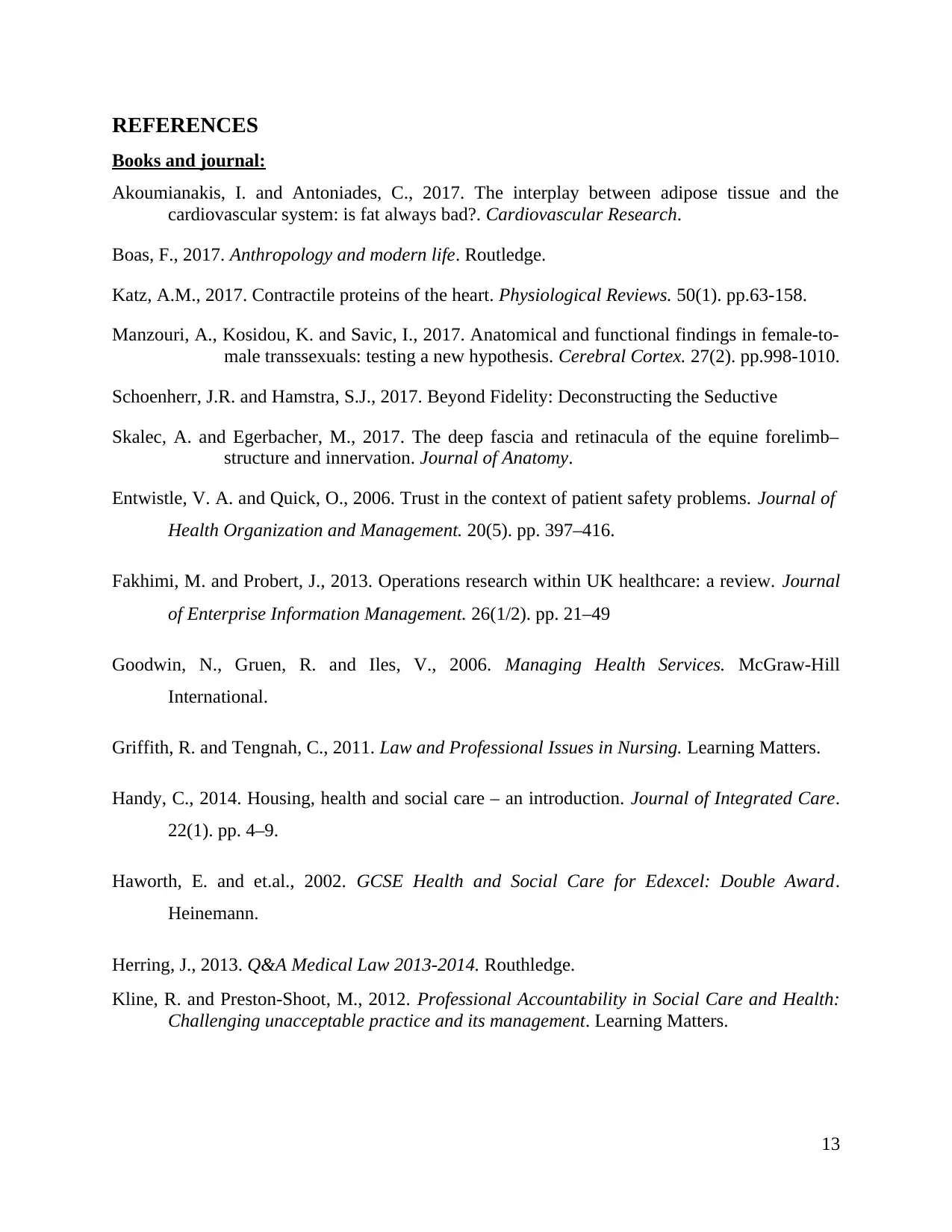
REFERENCES
Books and journal:
Akoumianakis, I. and Antoniades, C., 2017. The interplay between adipose tissue and the
cardiovascular system: is fat always bad?. Cardiovascular Research.
Boas, F., 2017. Anthropology and modern life. Routledge.
Katz, A.M., 2017. Contractile proteins of the heart. Physiological Reviews. 50(1). pp.63-158.
Manzouri, A., Kosidou, K. and Savic, I., 2017. Anatomical and functional findings in female-to-
male transsexuals: testing a new hypothesis. Cerebral Cortex. 27(2). pp.998-1010.
Schoenherr, J.R. and Hamstra, S.J., 2017. Beyond Fidelity: Deconstructing the Seductive
Skalec, A. and Egerbacher, M., 2017. The deep fascia and retinacula of the equine forelimb–
structure and innervation. Journal of Anatomy.
Entwistle, V. A. and Quick, O., 2006. Trust in the context of patient safety problems. Journal of
Health Organization and Management. 20(5). pp. 397–416.
Fakhimi, M. and Probert, J., 2013. Operations research within UK healthcare: a review. Journal
of Enterprise Information Management. 26(1/2). pp. 21–49
Goodwin, N., Gruen, R. and Iles, V., 2006. Managing Health Services. McGraw-Hill
International.
Griffith, R. and Tengnah, C., 2011. Law and Professional Issues in Nursing. Learning Matters.
Handy, C., 2014. Housing, health and social care – an introduction. Journal of Integrated Care.
22(1). pp. 4–9.
Haworth, E. and et.al., 2002. GCSE Health and Social Care for Edexcel: Double Award.
Heinemann.
Herring, J., 2013. Q&A Medical Law 2013-2014. Routhledge.
Kline, R. and Preston-Shoot, M., 2012. Professional Accountability in Social Care and Health:
Challenging unacceptable practice and its management. Learning Matters.
13
Books and journal:
Akoumianakis, I. and Antoniades, C., 2017. The interplay between adipose tissue and the
cardiovascular system: is fat always bad?. Cardiovascular Research.
Boas, F., 2017. Anthropology and modern life. Routledge.
Katz, A.M., 2017. Contractile proteins of the heart. Physiological Reviews. 50(1). pp.63-158.
Manzouri, A., Kosidou, K. and Savic, I., 2017. Anatomical and functional findings in female-to-
male transsexuals: testing a new hypothesis. Cerebral Cortex. 27(2). pp.998-1010.
Schoenherr, J.R. and Hamstra, S.J., 2017. Beyond Fidelity: Deconstructing the Seductive
Skalec, A. and Egerbacher, M., 2017. The deep fascia and retinacula of the equine forelimb–
structure and innervation. Journal of Anatomy.
Entwistle, V. A. and Quick, O., 2006. Trust in the context of patient safety problems. Journal of
Health Organization and Management. 20(5). pp. 397–416.
Fakhimi, M. and Probert, J., 2013. Operations research within UK healthcare: a review. Journal
of Enterprise Information Management. 26(1/2). pp. 21–49
Goodwin, N., Gruen, R. and Iles, V., 2006. Managing Health Services. McGraw-Hill
International.
Griffith, R. and Tengnah, C., 2011. Law and Professional Issues in Nursing. Learning Matters.
Handy, C., 2014. Housing, health and social care – an introduction. Journal of Integrated Care.
22(1). pp. 4–9.
Haworth, E. and et.al., 2002. GCSE Health and Social Care for Edexcel: Double Award.
Heinemann.
Herring, J., 2013. Q&A Medical Law 2013-2014. Routhledge.
Kline, R. and Preston-Shoot, M., 2012. Professional Accountability in Social Care and Health:
Challenging unacceptable practice and its management. Learning Matters.
13
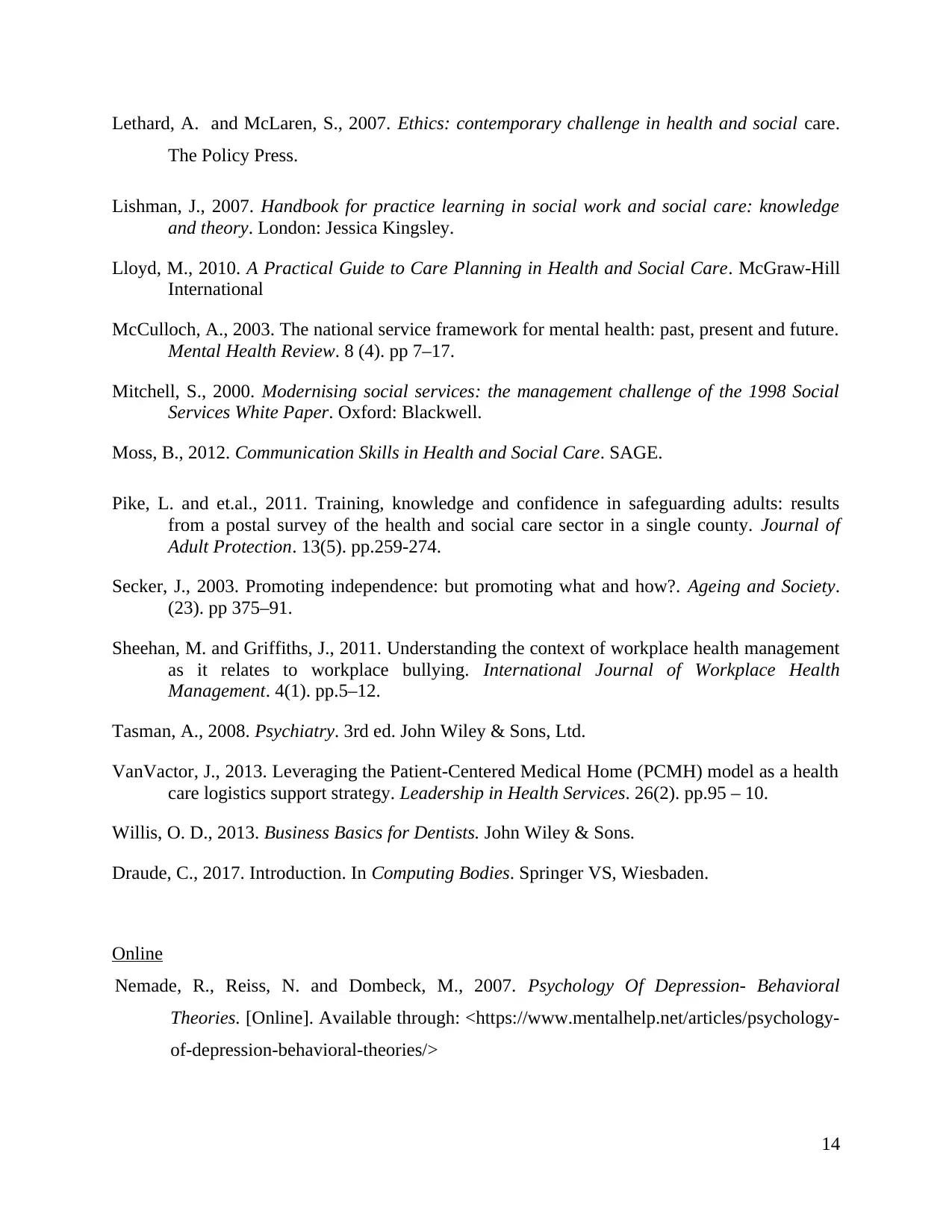
Lethard, A. and McLaren, S., 2007. Ethics: contemporary challenge in health and social care.
The Policy Press.
Lishman, J., 2007. Handbook for practice learning in social work and social care: knowledge
and theory. London: Jessica Kingsley.
Lloyd, M., 2010. A Practical Guide to Care Planning in Health and Social Care. McGraw-Hill
International
McCulloch, A., 2003. The national service framework for mental health: past, present and future.
Mental Health Review. 8 (4). pp 7–17.
Mitchell, S., 2000. Modernising social services: the management challenge of the 1998 Social
Services White Paper. Oxford: Blackwell.
Moss, B., 2012. Communication Skills in Health and Social Care. SAGE.
Pike, L. and et.al., 2011. Training, knowledge and confidence in safeguarding adults: results
from a postal survey of the health and social care sector in a single county. Journal of
Adult Protection. 13(5). pp.259-274.
Secker, J., 2003. Promoting independence: but promoting what and how?. Ageing and Society.
(23). pp 375–91.
Sheehan, M. and Griffiths, J., 2011. Understanding the context of workplace health management
as it relates to workplace bullying. International Journal of Workplace Health
Management. 4(1). pp.5–12.
Tasman, A., 2008. Psychiatry. 3rd ed. John Wiley & Sons, Ltd.
VanVactor, J., 2013. Leveraging the Patient-Centered Medical Home (PCMH) model as a health
care logistics support strategy. Leadership in Health Services. 26(2). pp.95 – 10.
Willis, O. D., 2013. Business Basics for Dentists. John Wiley & Sons.
Draude, C., 2017. Introduction. In Computing Bodies. Springer VS, Wiesbaden.
Online
Nemade, R., Reiss, N. and Dombeck, M., 2007. Psychology Of Depression- Behavioral
Theories. [Online]. Available through: <https://www.mentalhelp.net/articles/psychology-
of-depression-behavioral-theories/>
14
The Policy Press.
Lishman, J., 2007. Handbook for practice learning in social work and social care: knowledge
and theory. London: Jessica Kingsley.
Lloyd, M., 2010. A Practical Guide to Care Planning in Health and Social Care. McGraw-Hill
International
McCulloch, A., 2003. The national service framework for mental health: past, present and future.
Mental Health Review. 8 (4). pp 7–17.
Mitchell, S., 2000. Modernising social services: the management challenge of the 1998 Social
Services White Paper. Oxford: Blackwell.
Moss, B., 2012. Communication Skills in Health and Social Care. SAGE.
Pike, L. and et.al., 2011. Training, knowledge and confidence in safeguarding adults: results
from a postal survey of the health and social care sector in a single county. Journal of
Adult Protection. 13(5). pp.259-274.
Secker, J., 2003. Promoting independence: but promoting what and how?. Ageing and Society.
(23). pp 375–91.
Sheehan, M. and Griffiths, J., 2011. Understanding the context of workplace health management
as it relates to workplace bullying. International Journal of Workplace Health
Management. 4(1). pp.5–12.
Tasman, A., 2008. Psychiatry. 3rd ed. John Wiley & Sons, Ltd.
VanVactor, J., 2013. Leveraging the Patient-Centered Medical Home (PCMH) model as a health
care logistics support strategy. Leadership in Health Services. 26(2). pp.95 – 10.
Willis, O. D., 2013. Business Basics for Dentists. John Wiley & Sons.
Draude, C., 2017. Introduction. In Computing Bodies. Springer VS, Wiesbaden.
Online
Nemade, R., Reiss, N. and Dombeck, M., 2007. Psychology Of Depression- Behavioral
Theories. [Online]. Available through: <https://www.mentalhelp.net/articles/psychology-
of-depression-behavioral-theories/>
14

15
1 out of 16
Related Documents
Your All-in-One AI-Powered Toolkit for Academic Success.
+13062052269
info@desklib.com
Available 24*7 on WhatsApp / Email
![[object Object]](/_next/static/media/star-bottom.7253800d.svg)
Unlock your academic potential
© 2024 | Zucol Services PVT LTD | All rights reserved.




